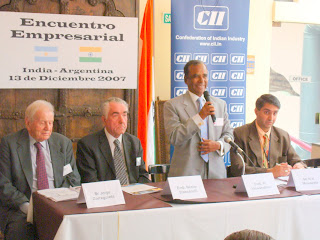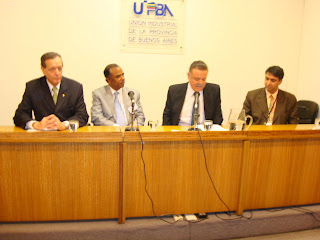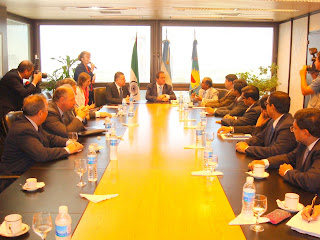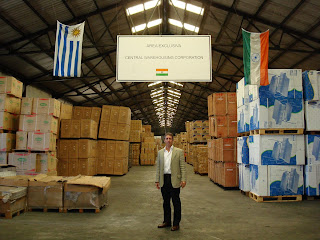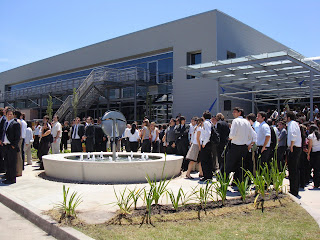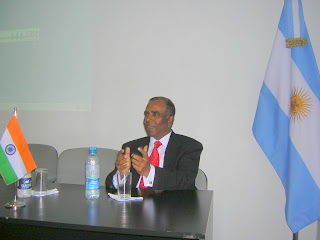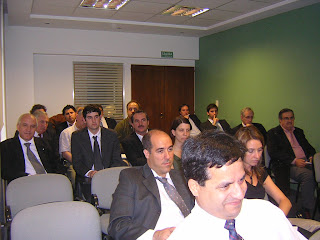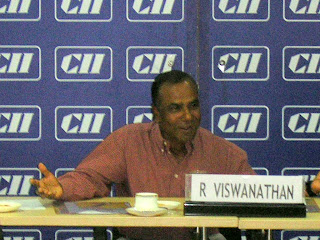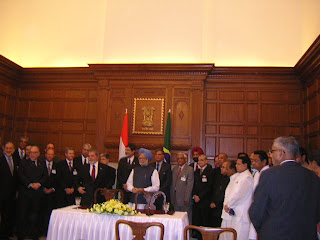the more exciting news first...
The Mexican embassy has started issuing five year multi entry business visas. Earlier they were issuing three year visa. You all know how it was three years back.
Credit for this goes to Ambassador Rogelio, who has moved heaven and the immigration dept for this.He got a four member delegation of the Immigration Dept here to look into the visa issues. In their meeting with me on 29 August, they took me by surprise asking me "what else they could do to attract Indian business visitors and make their visit more pleasant". They are going to liberalise the sytem further and faciliate work permits specially for the IT professionals.
The Ambassador is also organising the visit of a 103 member business delegation. List in the attachment. areas of interest include IT, callcentres, food products, pharma, chemicals, construction, textiles and giftitems. Delegation will arrive in delhi on friday 7 sept evening and be in delhi till 11th morning at Hotel Taj Palace. on 10 sept they will be in the bz seminar (CII- FICCI- Assocham) from 10.30am to 3 pm followed by individual bz meetings at Maurya Sheraton. President of mexico will addrss the seminar at 1300 hrs. IT part of the delegation will be in bangalore on 11th at Leela Hotel. Rest will be in Mumbai on 11-12 at Oberoi. 12th morning seminar by Assocham. for further info and contactVidya and Gunveena at CII and Luis Gerardo ( first secy) at the mexicanembassy
Our exports to mexico in 2006 were 1125 million dollars and imports 454million. I, the optimist, expect bilateral trade to touch 5 billion by 2010.Indian cos hv already invested 3 billion dollars in mexico. Besides its ownlarge mkt, mexico is the gateway to NAFTA and central American mkts. more details in my website.
Here is the list of the delegation ( name of delegate, name of company and and their areas and products of interest in that order). bit clumsy.. please bear with me
1
Alejandro
Artifibras, S.A. de C.V.
Food Products
2
Lorenzo
Asociación Mexicana de Parques Industriales
Association/Chamber/organization
3
Aurelio
Atento México
Call Center
4
Miguel
Bicicletas y Motocicletas Mercurio
Transportation
5
Nicolas
Bimbo
Food Products
6
Juan
Cámara nacional de la Industria Tequilera
Food Products
7
Juan Carlos
Caza Trading Co., S.A. de C.V.
Medical / Medicines
8
Sergio
Centro de Agronegocios de Colima
Food Products
9
Alejandro
Cinépolis
Entertainment
10
Sergio
COESA Ingenieria y Servicio, S.A. de C.V.
Information technology
11
Alejandro
COFOCE
Govt.
12
Luis
COMCE Nacional
COMCE/ Chamber of Commerce
13
Domingo
COMCE Sur
Construction Material
14
José Arturo
Food Products
15
Alejandro
Comex
Chemicals
16
José Andrés
Consorcio DMX
Food Products/ Beverages
17
Xavier
Constructuroa DMX
Construction
18
Victor Manuel
Controladora de Negocios, S.A. de C.V.
Construction
19
Enrique
Desarrolladora Espacio 5, S.A. de C.V.
Construction
20
Ricardo
Dulces Anahuac
Processed Food
21
Ernesto José
Eficasia
Call Center
22
Mauricio
Emwa
Gift Articles
23
Sócrates Alfredo
Exe Consultores
Information technology
24
José
Explosivos Asturión, S.A. de C.V.
Metal work (manufacturing of tractors, and other machinery)
25
Mateo Daniel
Fantasías Miguel, S.A. de C.V.
Gift Articles
26
Sergio
Frutas Tropicales de México, SPR de R:L.
Food Products
27
Guillermo
FUNTEC
Technological assistance / Foundation
28
Rodrigo
Genomma Lab
Pharma
29
Joaquín
Globe-Chemicals
Chemicals, Pharma
30
Gerardo
Gomex Termoplásticos, S.A. de C.V.
Chemicals
31
Abel
Grupo Corporativo AB-HU
Others
32
Roberto
Grupo Eiffel
Construction
33
Carlos Alberto
Grupo Grisi
Cosmetics and beauty products
34
Marco Tulio
Grupo Gylsa
Chemicals, Pharma
35
José Luis
Grupo IDESA
Petrochemicals
36
Francisco
Grupo Incom
Information technology
37
Rafael
Grupo Industrial Zaga
Textile
38
Lilia Judith
Grupo Loma
Gift Articles
39
Juan Carlos
Grupo Piagui
Footwear / Gift Articles
40
Francisco
Grupo Profusa
Construction
41
Elías
Grupo Toymark
Toys
42
Rodrigo
Has-it,, S.C.
Information technology
43
Gerardo
Homex
Home Construction/real estate (like DLF in India)
44
Alberto
Icorp
Information technology
45
Alejandra
IMBC
Services / Promotion
46
Jacinto
Importaciones y Exportaciones Jazen, S.A. de C.V.
Food products
47
Raymundo
Indigo
Others
48
María Eugenia
Instituto Mexicano de Teleservicios
Call Centers / BPO
49
Miguel
Insumos Internacionales GC
Plastic
50
Jorge
Inteqsoft
Information technology
51
Gonzalo
ITSON
Information technology
52
José J.
Jacob & Jacob
Energy
53
Vicente
Johnstone & Co.
Services
54
Luis
Laboratorios Pargon
Medical / Medicines
55
Carlos
Laboratorios Senosian
Pharma
56
Patricia
M & A Oil Co.
Petrochemicals
57
Vinod Kumar
Macroproyectos Inmobiliarios FAMA
Construction /Hotels
58
Richard
Maquitex
Textile/ Plastic
59
Roberto
Marquez Alonso Abogados
Services / Consultancy
60
Mauricio
Máxima Distinción (Emwa)
Gift Articles
61
Klaus Juerguen
Mediaccess, S.A. de C.V.
Medical / Medicines
62
Eduardo
Mega Direct
Call Center
63
Guillermo
Multiservices for Food Process, S.A.deC.V.
Food products
64
Alejandro Jorge
Nissan Autotal
Spare parts
65
Pablo
Nortel de México
Telecommunications
66
Antonio
Nova Chemical
Chemicals
67
José Oscar
Novaaire, S.A.
Tourism
68
Jorge
Omnilife
Food supplements
69
Rivelino
Philip International, S.A. de C.V.
Chemicals and processed food
70
Eduardo
Plastisor
Plastic
71
Eduardo
Polidi
Plastic
72
José Antonio
Poliformas
Chemicals
73
Mario
Polímeros y Derivados
Chemicals
74
Rafael
Information technology
75
Laura Adriana
Procesadora de Jaiba de Tampico, S.A. de C.V.
Food products
76
Manuel
Prodin Transformadores, S.A. de C.V.
Electricity
77
Jacobo
Proepta, S.A. de C.V.
Consumers goods
78
Ricardo
ProMéxico
Govt.
79
Luis
Prosaco / Protermo
Textile/ Plastic
80
Cesar
Quarksoft
Information technology
81
William
Rafisacos
Textile/ Plastic
82
Miguel
Rafitek
Textile
83
Alejandro
Resinas Sintéticas Oroz
Chemicals
84
Alejandro
Revita Group
Services
85
Rudolf
RH Shipping & Chartering, S.A. de C.V.
Transportation
86
Gerardo
Satarquim, S. de R.L. M.I.
Chemicals
87
Jesús
Govt.
88
Renato
Govt.
89
Ariadne Selene
Serral, S.A.de C.V.
Chemicals, Pharma
90
José Rolando Miguel
Servicios Rotativos de Calidad, S.A. de C.V.
Metal work (manufacturing of tractors, and other machinery)
91
Gerardo
Starquim, S. de R.L. M.I.
Chemicals
92
Roberto
Taiwán Mayorista, S.A. de C.V.
Home appliances and furniture
93
Pedro Miguel
Tatung México, S.A. de C.V.
Home appliances
94
Ilangovan
Tecnológico de Monterrey
Technology
95
Higinio
Telvista
Call Center
96
Justin
Tiba
Services / Logistics
97
Jorge
Total Energy Systems
Energy
98
Héctor
Valvulas Worcester de México, S.A. de C.V.
Metal work (manufacturing of tractors, and other machinery)
99
Enrique
Vignette de México S de RL de CV
Information technology
100
José Miguel
Windsor Ciclismo, S.A. de C.V.
Transportation
101
Eugenio
Xignux
Information technology
102
Raymundo
ZacSoft
Information technology
103
Elías
Construction
